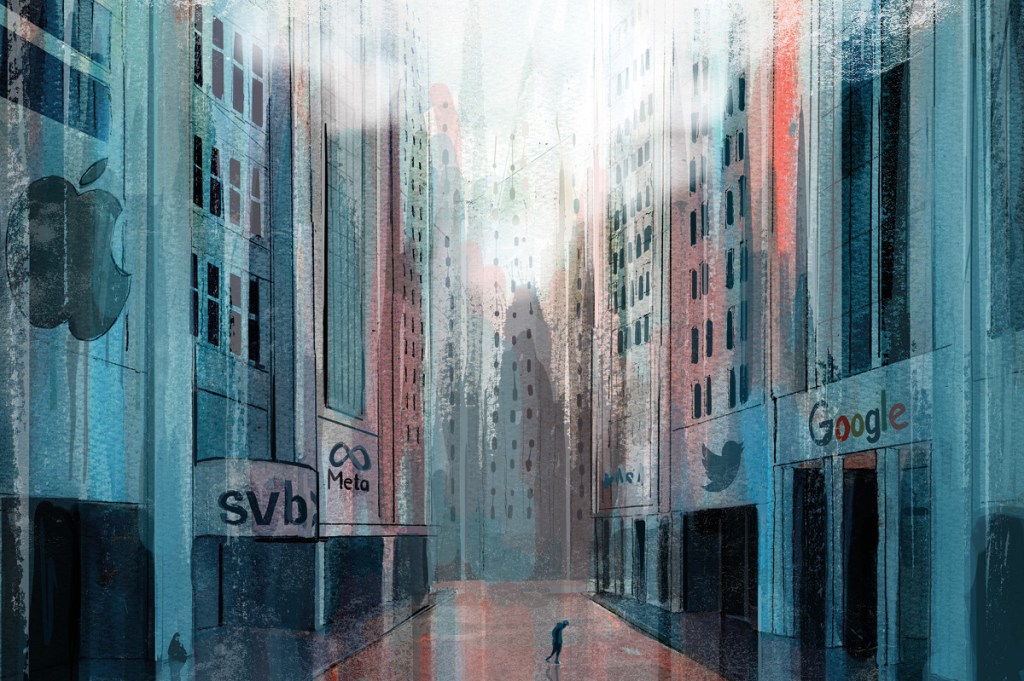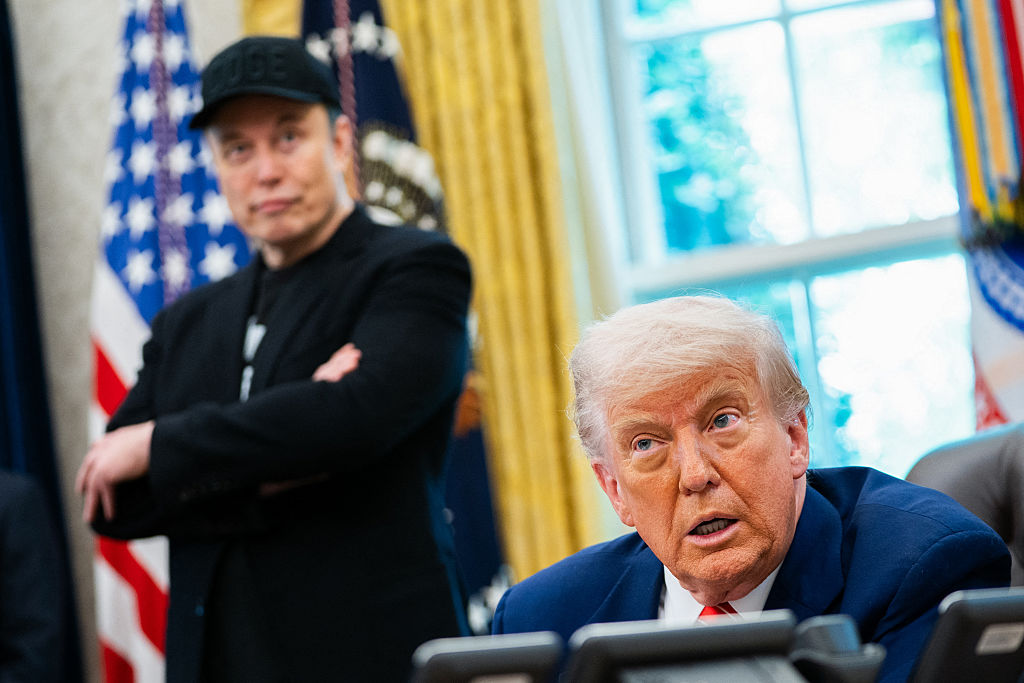It is difficult, given what Silicon Valley has become, to convey exactly what it was like in the 1970s and ‘80s. It was a remarkable center of technology, but also the embodiment of the spirit of capitalism at its very best, as epitomized by garage start-ups like Apple. Greed, of course, is always a human motivation, but the early Valley culture was created by entrepreneurial outsiders who genuinely wanted to make the world better.
In the early days of the tech revolution, some watchers imagined an almost utopian, communitarian society on the horizon. In 1972, the California writer and zeitgeist diagnostician Stewart Brand predicted in Rolling Stone that when computers became widely available, we would all become “Computer Bums, all more empowered as individuals and as co-operators.” It would be a new era of enhanced “spontaneous creation and of human interaction.” The “early digital idealists,” tech guru Jaron Lanier recalled in 2014, envisioned a “sharing” web that functioned “free from the constraints of the commercial order.”
I was there, working as West Coast editor for Inc. magazine (itself one of the premier media startups of the era). I remember those early Silicon Valley days as a period of extreme competition, with scores of companies battling to dominate emerging industries like laptop computers, disc drives and networking systems. One brilliant marketer and publicist, Regis McKenna, could offer a reporter scores of new companies to visit, mostly backed by venture capitalists. You could spend days interviewing remarkable people, all of whom seemed convinced theirs could be the next Hewlett Packard or Intel.
One of the firms Regis introduced me to was Silicon Valley Bank, whose founder Roger Smith epitomized the excited optimism of that time. Roger’s enthusiasm was infectious and the assiduous way he worked the Valley’s network of startups made him something of a local hero. As recently as a decade or so ago, even radicals saw the Silicon Valley crowd as an improvement on the old corporate elite. At the Occupy Wall Street protests in 2011, anti-capitalist demonstrators held moments of silence and prayer in memory of Steve Jobs, whom they seem not to have realized was a preternaturally ruthless capitalist. Some people still see Bill Gates, a clear monopolist, as, in the words of the left-wing French economist Thomas Piketty, one of the “meritorious entrepreneurs.” One progressive writer, David Callahan, portrays the tech oligarchs, along with their allies in the financial sector, as members of a sort of “benign plutocracy” in contrast to those past tycoons who built their fortunes on resource extraction, manufacturing and encouraging endless material consumption.
This distinction goes back to the ethos that defined the Valley in its early days. But very little remains of that founding culture. America’s tech titans have attained oligopolistic sway over markets comparable to that of John D. Rockefeller, Andrew Carnegie and Cornelius Vanderbilt. They may wear baseball caps rather than top hats, but their economic and cultural power is as vast — and their rise has been the death knell of the Valley’s bracing entrepreneurial culture.
‘We used to build the future. Then we designed it, now we just think about it’
The collapse of Silicon Valley Bank is the latest indicator that the Valley — site of nothing less than an economic miracle in recent decades — is now in big trouble. Other signs include mass layoffs in the tech sector and a post-pandemic real estate downturn. The Valley, it seems, is entering a period of decadence that raises the prospect of long-term decline.
The start of this decline has coincided with a shift from the physical to the virtual. The Valley’s roots were in the old engineer-driven economy, one connected to the rest of the country, and to working-class America — somebody, it’s easy to forget, has to make the hardware. Today tech is dominated by a cognitive elite of Ivy Leaguers, management consultants and MBAs. “We used to build the future,” Leslie Parks, who formerly directed redevelopment efforts in San Jose, once told me. “Then we designed it, now we just think about it.”
But the Valley has slowly left the industrial battlefield — it has lost over 160,000 manufacturing positions over the past two decades. It bought into the idea that the unique genius of its financial and corporate culture would be enough for it to thrive and profit as production headed first to Japan, then China and, more recently, to other parts of North America.
This is a familiar story. Consider, for example, how British industry lost its edge: the Industrial Revolution created a new class of tycoons; then the tycoons’ sons sought a return to the aristocratic past, eschewing dirty factories for elegant postings in the City or a relaxed life in their country estates. More recently, Detroit’s world-beating automotive industry squandered its technological and manufacturing advantages in a rush, pushed by Wall Street and its own financial managers, to earn easy profits from inferior products.
To be clear, the Valley is not done as a major tech center. It still boasts a venture capital community, a remarkable concentration of engineering and other management talent, powerful universities and the headquarters of some of the biggest companies in the world. And it remains home to many of the tech giants that now exploit their monopolistic advantages. But that is not the same thing as being the place where the world looks for a vision of the future, as it once was. Even if the Valley still matters, it may no longer dominate the future as its denizens once assumed it would. Instead, it will face fierce competition for tech supremacy — from other countries, and other parts of this one.
This reflects two different phenomena: rising competition from other regions — and an internal rot that has infected the Valley. In its first few remarkable decades, the Valley was defined by its openness, its culture of competition and connection to the general economy. The people who built it, such as David Packard and Bill Hewlett, Fairchild Semiconductor co-founder Robert Noyce, and Apple’s Steve Jobs were, foremost, industrialists. They had a vision of how to use new technology to enhance productivity and make money.
Over the last decade or two, the Valley has outsourced much of its industry. Apple produces two-fifths of its products in China, more than four times what is made in the United States. Other tech giants don’t make anything. Rather than trying to build a better mousetrap, big tech now makes much of its billions off surveillance — the source of the wealth generated by Google and Meta — and by disintermediating retail businesses. It is a far cry from the optimistic promise of a better tomorrow on which the Valley was built.
Three tech firms now account for two-thirds of all online advertising revenues, which now represent the vast majority of all ad sales, controlling in some cases upwards of 90 percent of the market. Even in bad years, they can persist by laying off employees, relying on inertia to garner income without worry of competition in what the author David P. Goldman neatly summarizes as “the transformation of disruptive tech companies into rent-seeking monopolies.”
Many progressives persist in seeing the Golden State, and particularly Silicon Valley, as harbingers of a better, greener, more egalitarian future. In the words of two leading academics “California Capitalism” remains “distinctive,” “a model of an environmentally friendly economy that epitomizes fiscal responsibility, innovation” as well as “inclusive, sustainable, long-term growth.”
This vision could not be further from reality. The stranglehold of mega-firms and the associated Wall Street and venture capital money machine has undermined competition in fields from video games to artificial intelligence to cloud services to the metaverse and AI. To be sure, there’s some competition among the giants, much as there was between aristocratic clans in Europe or Japan’s feudal daimyo, but there are vanishingly diminished opportunities for the sort of startup that made up much of Silicon Valley Bank’s deposit base. Tech today is largely a game played between giants who, if they see promising technology, simply acquire it. Tech entrepreneur turned author Antonio García Martínez has called the contemporary Valley “feudalism with better marketing,” a “highly stratified” quasi-medieval society “with little social mobility.” With control of key markets, firms that columnist Michael Lind refers to as “toll-booth companies” can exact money from consumers who have little choice of going elsewhere — a bit like feudal lords. And if these barons compete, it is against one another. Largely ignored has been the impact of these changes on the people who live in the Valley. In the Eighties and Nineties it was heralded as “an exemplar of middle-class aspiration.” No longer. And that, too, is thanks in part to deindustrialization.
The kinds of tech jobs being created in the Valley produce opportunities only for a narrow subset of highly skilled, well-connected or credentialed employees. The Bay Area has been described as “a region of segregated innovation.” Lower- and even mid-level workers at firms such as Google sometimes sleep in their cars while others have been forced into mobile-home parks or even homeless encampments.
As the Valley has become more feudal, its political culture has become more uniformly progressive
Perhaps nowhere is the social rot more evident than in San Francisco, arguably America’s premier high-tech city but now more associated with high crime rates, homelessness and disorder.
Oddly, as the Valley has become more feudal — its reliance on “indentured” H-1B visa holders repeats a very old arrangement — its political culture has become more uniformly progressive. Back in its heyday, the Valley’s disproportionate number of eccentric and oddball engineers and tech visionaries belied a pragmatic political culture. It was a place where middle-of-the-road pragmatists in either party would be heard. In the Eighties and Nineties, Silicon Valley, like many industries, placed its bets on both political parties. Moderate Republicans, such as Pete McCloskey, Ed Zschau and Tom Campbell, and pro-business Democrats, such as Bill Clinton, all did well there.
Today’s Valley is a political monolith, with virtually no elected Republicans. Almost all 2016 and 2018 contributions from Silicon Valley tech owners and employees went to Democrats. Tech money helped Governor Gavin Newsom outspend his GOP rival three to one — with major contributions from former Yahoo CEO Marissa Mayer and Laurene Jobs (widow of the Apple founder) at the top of the donor list. Tech’s successful seduction of the DC establishment was first evident in the Obama years, and they repaid their allies by censoring information during the 2020 campaign, with increasingly politi- cized algorithms monitoring online language to the ultimate benefit of one party.
Now the Valley could be called the epicenter of the “gentry progressive” universe. In 2020 former Google chairman Eric Schmidt headed data efforts for several Democratic presidential candidates, including Joe Biden, Kamala Harris, Cory Booker and Elizabeth Warren. Five of the top eight Biden donors in that cycle came from tech firms. Also in 2020, the Chan-Zuckerberg initiative committed $300 million to boosting progressive-voter turnout.
There’s some notion that this single-mindedness may have contributed to recent Valley disasters. SVB’s board was packed with Hillary Clinton, Biden and Obama backers. The bank invested in nonprofits linked to Governor Gavin Newsom, and serviced left-wing media such as Vox and the troubled progressive site BuzzFeed. Some on the right have been happy to tie the bank’s decline to its inordinate attention to such non-banking concerns as climate change, racial justice and other progressive causes. This point may be exaggerated, but certainly the board did not seem to focus on the basics. The bank may also have expected gentle handling from the San Francisco Federal Reserve, which has also been focused on the adoption of progressive policies, and which seems to have dozed as the company moved towards bankruptcy.
It might not have been so odd for SVB to expect the fairly gentle handling it ended up getting: in recent years, the tech industry as a whole has developed one of the most powerful lobbies in Washington, cultivating supporters both on the right and left. A decade ago, Joe Green, a former roommate of Facebook founder Mark Zuckerberg and head of the Valley lobbying group FWD.us, suggested in a leaked memo that “people in tech” can become “one of the most powerful political forces” in the country since they increasingly “control” what he labeled “the avenues of distribution.” He was right. Once known as quirky outsiders, the Valley is now the establishment. They even recently dragooned former defense and intelligence officials into signing a letter arguing that these companies are essentially “national treasures” and should not be subject to antitrust or other regulatory curbs. Some of this would be more understandable if big tech embraced the idea of national interest.
Yet despite all the money and power, fewer and fewer people, in or out of politics, share this enthusiasm for these “national treasures.” Today the vast majority of Americans are inclined to fear the tech elite, and the industry’s approval dropped dramatically even before the pandemic. Today’s Valley is a far cry from the life-improving, concrete promise of twentieth-century industrial achievement. People see that tech’s giants reap fortunes from ever greater surveillance and socially destructive social media; tech’s contributions to well-being and economic prosperity are far more difficult to keep front of mind.
And as competition declines, the incentive to manipulate information, and boost profits through surveillance, seems to be irresistible. This is far more pervasive in terms of political and cultural life than, say, the power of the Big Three in Detroit’s heyday. Henry Ford may have been an awful human being, but he couldn’t have surveilled his employees, much less his customers, like Google or Meta. Nor did the titans of the auto age seek dominion in fields as diverse as healthcare, space travel, entertainment and, of course, cars themselves.
Today’s tech giants are more akin to high-tech zaibatsu, the almighty Japanese conglomerates, than the heroic good guys of “let’s put on a show!” tech innovation. Their leaders have become middle-aged tycoons who’ve created a modern version of Middle Ages feudalism, and they’re unsurprisingly facing something of a peasant’s rebellion. A socialist movement is even percolating among tech employees, many of whom see little opportunity to amass enough wealth just to buy a house in the exorbitant Bay Area. In 2021 Knock.com estimated that, at current prices, households with median income would need more than a century to save for a down payment on the median-priced new home in San Jose, San Francisco or Los Angeles.
The degree to which the Biden administration and federal economic entities seem compelled to protect the richest moguls and the largest companies have become very troubling indeed.
The Treasury’s response to the SVB and other bank crises is built on the need to protect the venture capital industry, suggesting its strategic value in the economy as justification for bailing out billionaires and their investments. The middle- and working-class pay to bail out giant depositors, either directly or by higher insurance fees, while the big financial institutions will now step in and pick the strongest remaining candidates out of SVB’s leftovers, further consolidating their hold on America’s once widely dispersed financial system.
To stand up against such wealth and power will require a melding of the two populist movements: the right-wing nationalists and the traditional, pro-worker left. By their often excessive public consumption — private planes, giant yachts, bespoke space travel — the present-day oligarch-barons look like minor feudal lords, and their incessant virtue-signaling comes across as a high-tech version of sumptuary laws: “Space flight for me and not for thee.”
Does all this suggest the Valley is finished? Not quite. Inertia is a mighty force. But something essential to the area’s success has been lost and with it the Valley’s hegemony over technology. The kingdom’s spell has been broken, no doubt accelerated by the SVB collapse. The Valley may be a critical tech center for the foreseeable future, but it will no longer be the undisputed tech center.
If Silicon Valley’s decline is exaggerated by some, and its demise prematurely proclaimed, notably in the conservative press and among Easterners who generally disdain California for its many successes, the process is undeniable and steady. And unless there is a significant change in the political direction of the state of California, a long-term and inexorable hollowing out of the Valley seems inevitable. Something unique, and miraculous, will be lost into the mists of history and legend.
This article was originally published in The Spectator’s May 2023 World edition.

























